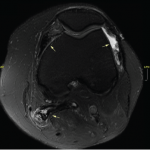BOSTON—Research on two members of the immunoglobulin superfamily of proteins, CTLA-4 and PD-1, may one day generate novel, targeted therapies for autoimmune rheumatic diseases, such as rheumatoid arthritis (RA) and systemic lupus erythematosus (SLE).
These signaling pathways each play significant roles in the process of autoimmunity, said Vassiliki A. Boussiotis, MD, PhD, professor of medicine at Harvard Medical School and Beth Israel Deaconess Medical Center. At the lecture, Co-Stimulation Pathways: Therapeutic Opportunities for the Rheumatic Diseases, held Nov. 19, 2014, at the ACR/ARHP Annual Meeting in Boston, Dr. Boussiotis discussed how stimulatory and inhibitory pathways may help regulate T cell responses. Developing agents to manipulate these co-stimulation pathways may help rheumatologists block the destructive effects of autoimmunity on organs and tissues.
Prevent Destruction
T cells play essential roles as orchestrators or effectors of the immune system, she said. “One of the most important properties of the immune system is its ability to recognize foreign antigens and respond to those foreign antigens while preventing destructive immune responses against autologous tissues in the host.” In autoimmunity, this control or delicate balance is lost, and the result is injuries to vital organs and tissues that one sees in such diseases as RA and lupus.
During thymic selection, the majority of self-reactive T cells are eliminated via a process called central tolerance, Dr. Boussiotis said. However, a fraction of these cells may escape and retain the potential to inflict destructive autoimmune pathology against their host. The immune system has other mechanisms to prevent such attacks of escaping cells, chiefly induction of peripheral tolerance. This is a complex network of stimulatory and inhibitory receptors and ligands, and they send cell-to-cell signals that dictate the outcome of T cell encounters with the cognate antigen, she said.

T-regulatory cells, which exert cell-extrinsic control over these autoreactive T cells, also play an important role in this process. “Cell-extrinsic mechanisms, which mostly depend on the presence of regulatory cells, use many of these cognate ligands and their receptors in order to mediate these cell-extrinsic suppression functions to the T cells,” said Dr. Boussiotis.
Two important receptors, cytotoxic T-lymphocyte protein 4 (CTLA-4) and programmed cell death protein 1 (PD-1), are both involved in peripheral tolerance. Blocking agents to these molecules are being developed as anticancer therapies. These two proteins’ unique molecular structures, the expression patterns of their receptors and ligands, and their mechanisms of cell-intrinsic and cell-extrinsic activity make their therapeutic potential in rheumatic diseases intriguing, she said.
CTLA-4 shares 29% homology with another protein expressed on T cells, CD28, and binds to the same B7 ligands, B7-1 and B7-2. Yet it binds with a higher affinity to these ligands than CD28, “because it has the ability to form homodimers, and by doing so, CTLA-4 allows bivalent binding of B7 molecules, which is not feasible for CD28,” said Dr. Boussiotis. CTLA-4 is a negative regulator of T cell responses. It mediates an inhibitory response, and the cross-linking of the CTLA-4 receptors in the presence of T cell receptor and CD28 stimulation results in a suppression of cytokine production.
‘PD-1 is there to protect the host from immune-mediated tissue destruction, which is so important in the setting of chronic antigen stimulation.’
T cells in the thymus exit the gland at a high, rapid rate. If these cells have escaped central tolerance and display specificity for endogenous antigens, they can infiltrate multiple tissues in the periphery, such as the heart and pancreas, Dr. Boussiotis said. CTLA-4 regulates the activation and expansion of T cells with specificity for endogenous antigens so it can help protect these organs and tissues. CD4 and T-regulatory cells play a dominant role in regulating autoimmune pathology in the context of CTLA-4 deficiency in a cell-extrinsic manner. This deficiency in regulatory cells changes the ability of antigen-presenting cells to express B7 molecules.
Multiple polymorphisms and splice variants of CTLA-4 have been associated with autoimmune diseases, such as RA, lupus, Hashimoto’s thyroiditis, multiple sclerosis, type 1 diabetes and Graves’ disease.
Protective Qualities
PD-1 is also present on the surface of T cells, and binds to two ligands, PD-L1 and PD-L2, said Dr. Boussiotis. Importantly, PD-L1 and PD-L2 are expressed not only on the activated antigen-presenting cells, but also on nonhematopoietic tissues, and for this reason, these ligands play a critical role in the regulation of autoimmunity in peripheral organs. PD-1 deficiency may result in delayed-onset, organ-specific autoimmunity, which can vary depending on the host’s genetic background, she said. PD-1-deficient mice have developed a lupus-like syndrome with arthritis and glomerulonephritis after six months of age.
PD-1 may function as a physiologic inhibitor of autoimmune lymphocyte responses in peripheral tissues, she said. As a consequence, PD-1 deficiency results in cardiomyopathy, which is mediated by antitroponin 1 antibodies, and it may also accelerate autoimmunity in such diseases as experimental autoimmune encephalomyelitis, colitis, diabetes and pneumonitis.
“What is unique about the PD-1 pathway is its expression and function in what we call exhausted T cells, and we are all aware that blocking the effects of PD-1 by blocking antibodies in these cells induces reinvigoration of the cells in the context of chronic infections,” said Dr. Boussiotis. Models that show this effect include patients with hepatitis B and C, and human immunodeficiency virus (HIV). However, when the PD-1 ligand is lost, mice get fulminant viral infection and die due to the autoimmune pathology, she said. “That is an important teaching point for us. It tells us that PD-1 is there to protect the host from immune-mediated tissue destruction, which is so important in the setting of chronic antigen stimulation.”
Although PD-1 shares 17% homology with CTLA-4, it lacks that extracellular cysteine residue required for covalent dimerization, and it is monomeric on the cell surface, Dr. Boussiotis said. It also lacks the MYPPY motif seen on CTLA-4, which confers interaction with B7-1 and B7-2 cells, and the SH2- and SH3-binding motifs seen on the cytoplasmic tails of CTLA-4. Instead, PD-1’s cytoplasmic domain contains two immunoreceptor tyrosine-based switch motifs that are PD-1’s key regulators, ITIM and ITSM. The recruitment of SHP2 and, potentially, SHP1, are mandatory for PD-1-mediated inhibitory function, and “only in the context of co-ligation do you see SHP2 recruitment,” she said.
Findings from various laboratory studies suggest that PD-1 mediates protection from immune-mediated tissue damage through the initiation of a feedback-negative pathway, Dr. Boussiotis said. PD-1 regulates the generation and expansion of self-reactive T cells and protects targeted tissue damage. Splice variants of PD-1 have been identified, and one may be a key regulator of autoimmunity in factor-negative RA, she said. Research has focused on 50 different PD-1 polymorphisms and their role in the clinical presentation and progression of rheumatic diseases, such as RA, SLE, lupus nephritis and ankylosing spondylitis.
There are two probable approaches for therapeutic use of CTLA-4 and PD-1, Dr. Boussiotis said. Antagonists might block their inhibitory function and enhance the immune response in cancer or chronic infections. Agonists might take advantage of their inhibitory responses and be put to use in autoimmune diseases, graft rejection and graft vs. host disease, she said. In the context of rheumatic diseases, the goal is to activate their mediated inhibition of aberrantly activated, autoreactive T cells, she said. Targeting CTLA-4 might increase the activation threshold and prevent the generation of effector cells. Targeting PD-1 might restrain the expansion of antigen-specific effectors, primarily in nonlymphoid organs.
A great deal of research is needed to reach these important goals, Dr. Boussiotis said. Both CTLA-4 and PD-1 may represent truly novel approaches to induce the quiescence of autoreactive T cells in many rheumatic diseases and one day help prevent autoimmunity.
Susan Bernstein is a freelance medical journalist based in Atlanta.
Second Chance
If you missed this session, it’s not too late. Catch it on SessionSelect.

